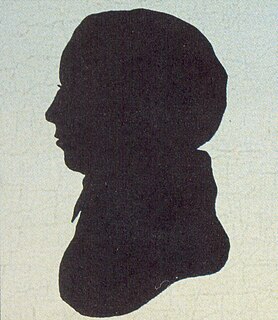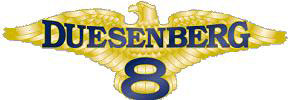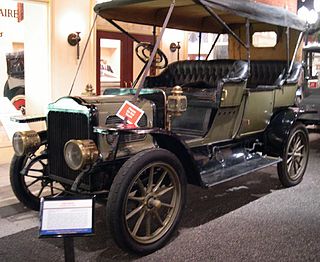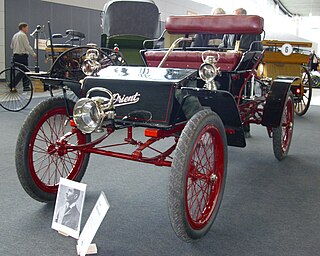Related Research Articles

Francis Cabot Lowell was an American businessman for whom the city of Lowell, Massachusetts, is named. He was instrumental in bringing the Industrial Revolution to the United States.

The Brass Era is an American term for the early period of automotive manufacturing, named for the prominent brass fittings used during this time for such things as lights and radiators. It is generally considered to encompass 1896 through 1915, a time when these vehicles were often referred to as horseless carriages.

The Waltham Watch Company, also known as the American Waltham Watch Co. and the American Watch Co., produced about 40 million watches, clocks, speedometers, compasses, time fuses, and other precision instruments between 1850 and 1957. The company's historic 19th-century manufacturing facilities in Waltham, Massachusetts have been preserved as the American Waltham Watch Company Historic District.

Aaron Lufkin Dennison was an American watchmaker and businessman who founded a number of companies.

Duesenberg Motors Company was an American manufacturer of racing cars and high-end luxury automobiles. It was founded by brothers August and Frederick Duesenberg in 1913 in Saint Paul, Minnesota, where they built engines and racing cars. The brothers moved their operations to Elizabeth, New Jersey, in 1916 to manufacture engines for World War I. In 1919, when their government contracts were cancelled, they moved to Indianapolis, Indiana, home of the Indianapolis Motor Speedway, and established the Duesenberg Automobile and Motors Company, Inc. (Delaware). In late 1926, E.L. Cord added Duesenberg to his Auburn Automobile Company. With the market for expensive luxury cars severely undercut by the Great Depression, Duesenberg folded in 1937.

A steam car is a car (automobile) propelled by a steam engine. A steam engine is an external combustion engine (ECE) in which the fuel is combusted outside of the engine, unlike an internal combustion engine (ICE) in which fuel is combusted inside the engine. ECEs have a lower thermal efficiency, but carbon monoxide production is more readily regulated.

The Peerless Motor Car Company was an American automobile manufacturer that produced the Peerless brand of motorcars in Cleveland, Ohio, from 1900 to 1931. One of the "Three Ps" – Packard, Peerless, and Pierce-Arrow – the company was known for building high-quality luxury automobiles. Peerless popularized a number of vehicle innovations that later became standard equipment, including drum brakes and the first enclosed-body production cars.

The Stutz Motor Car Company of America, Inc., was an American producer of high-end sports and luxury cars based in Indianapolis, Indiana, USA. Production began in 1911 and ended in 1935.

Waltham Manufacturing Company (WMC) was a manufacturer of bicycles, motorcycles, motorized tricycles and quadricycles, buckboards, and automobiles in Waltham, Massachusetts. It sold products under the brand names Orient, Waltham, and Waltham-Orient. The company was founded in 1893, moving to self-propelled vehicles after 1898.
Abner Doble was an American mechanical engineer who built and sold steam-powered automobiles as Doble Steam Cars. His steam engine design was used in various automobiles from the early 1900s, including a 1969 General Motors prototype and the first successful steam-powered aeroplane.

The Dragon Automobile Company manufactured automobiles from 1906 to 1908, first in Detroit, Michigan, and then in Philadelphia, Pennsylvania. It was followed, briefly, by the Dragon Motor Company.

Frederick Samuel Duesenberg was a German-born American automobile and engine designer, manufacturer and sportsman who was internationally known as a designer of racecars and racing engines. Duesenberg's engineering expertise influenced the development of the automobile, especially during the 1910s and 1920s. He is credited with introducing an eight-cylinder engine, also known as the Duesenberg Straight-8 engine, and four-wheel hydraulic brakes, a first for American cars, in addition to other mechanical innovations. Duesenberg was also patentholder of his designs for a four-wheel hydraulic brake, an early automatic transmission, and a cooling system, among others. Fred and his younger brother, August "Augie" Duesenberg, shared the patents, filed in 1913 and renewed in 1918, for their "walking beam" four-cylinder engine and the Duesenberg Straight 8.

August Samuel Duesenberg was a German- born American automobile and engine manufacturer who built American racing and racing engines that set speed records at Daytona Beach, Florida, in 1920; won the French Grand Prix in 1921; and won Indianapolis 500-mile races, as well as setting one-hour and 24-hour speed records on the Bonneville Salt Flats in Utah in 1935. He also shared with his older brother, Frederick S. "Fred" Duesenberg, patents filed in 1913 and renewed in 1918 for a four-cylinder engine design and the Duesenberg Straight 8.
The Detroit Automobile Company (DAC) was an early American automobile manufacturer founded on August 5, 1899, in Detroit, Michigan. It was the first venture of its kind in Detroit. Automotive mechanic Henry Ford attracted the financial backing of twelve investors; Detroit Mayor William Maybury, William H. Murphy and others. As with many early car ventures, the company floundered and was dissolved in January 1901. Twenty vehicles were built and $86,000 of investment was lost.

Caleb Smith Bragg was an American racecar driver, speedboat racer, aviation pioneer, and automotive inventor. He participated in the 1911, 1913 and 1914 Indianapolis 500. In speedboat racing, Caleb won three consecutive APBA Challenge Cup races in Detroit from 1923-1925. He was a co-inventor of the Bragg-Kliesrath brake.

Gilbert "Gil" Andersen was a Norwegian-American racecar driver active during the formative years of auto racing.
Charles Moran Jr. was an American racecar driver and managing partner of Francis I. DuPont, brokerage firm.

E. Howard & Co. was a clock and watch company formed by Edward Howard and Charles Rice in 1858, after the demise of the Boston Watch Company. The pair acquired some of the material and watches in progress, based upon a lien against the defunct company held by Rice, but they were unable to buy the existing factory or machinery, so they moved to Roxbury. Soon afterwards, Howard bought out Rice's interest and thereafter sought to make high quality watches based on his own unique designs and eccentric production methods. E. Howard & Co. also produced regulators, and marine clocks.

The Waltham Steam was an American steam car.
The automotive industry in Massachusetts refers to a period of time from 1893 to 1989 when automobiles were manufactured in the Commonwealth of Massachusetts commercially. During this time, the state produced more automobiles than Detroit, Michigan. During the 20th century, General Motors and the Ford Motor Company were producing automobiles at the Framingham Assembly and Cambridge Assembly, respectively.
References
- Hiscox, Gardner Dexter (1900), "Waltham Manufacturing Co.", Horseless vehicles, New York: N. W. Henley & co., OL 7244186M
- G. N. Georgano (editor): Complete Encyclopedia of Motorcars, 1885 to the Present. New York: Dutton Press, 2nd edition (Hardcover) 1973, ISBN 0-525-08351-0
- Kimes, Beverly Rae (2005). SAE International (ed.). Pioneers, Engineers, and Scoundrels: The Dawn of the Automobile in America. Warrendale, Pennsylvania. ISBN 0-7680-1431-X.